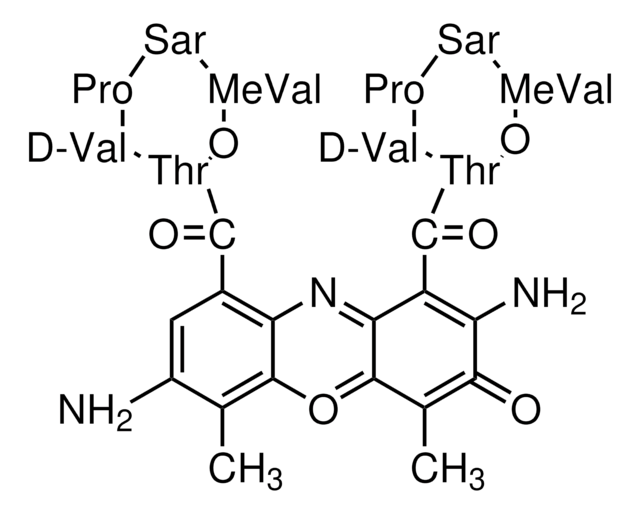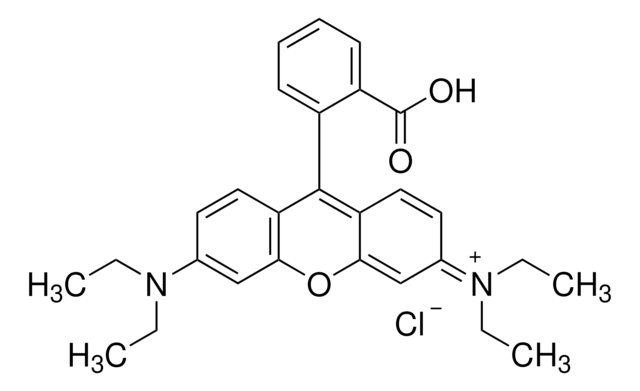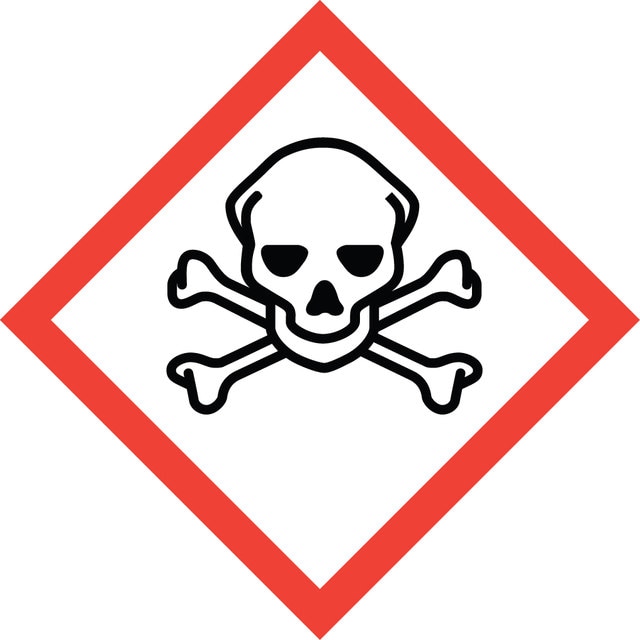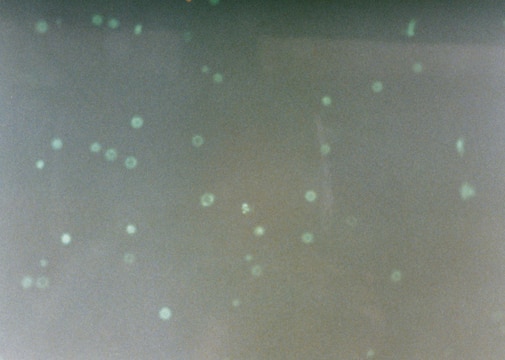A9400
7-Aminoactinomycin D
~97% (HPLC), powder
Synonym(s):
7-AAD
About This Item
Recommended Products
assay
~97% (HPLC)
Quality Level
form
powder
color
red to very dark purple
antibiotic activity spectrum
neoplastics
mode of action
DNA synthesis | interferes
storage temp.
2-8°C
SMILES string
CC(C)[C@H]1NC(=O)[C@@H](NC(=O)c2cc(N)c(C)c3OC4=C(C)C(=O)C(N)=C(C(=O)N[C@H]5[C@@H](C)OC(=O)[C@@H](C(C)C)N(C)C(=O)CN(C)C(=O)[C@@H]6CCCN6C(=O)[C@H](NC5=O)C(C)C)C4=Nc23)[C@@H](C)OC(=O)[C@H](C(C)C)N(C)C(=O)CN(C)C(=O)[C@@H]7CCCN7C1=O
InChI
1S/C62H87N13O16/c1-26(2)42-59(85)74-21-17-19-36(74)57(83)70(13)24-38(76)72(15)48(28(5)6)61(87)89-32(11)44(55(81)66-42)68-53(79)34-23-35(63)30(9)51-46(34)65-47-40(41(64)50(78)31(10)52(47)91-51)54(80)69-45-33(12)90-62(88)49(29(7)8)73(16)39(77)25-71(14)58(84)37-20-18-22-75(37)60(86)43(27(3)4)67-56(45)82/h23,26-29,32-33,36-37,42-45,48-49H,17-22,24-25,63-64H2,1-16H3,(H,66,81)(H,67,82)(H,68,79)(H,69,80)/t32-,33-,36+,37+,42-,43-,44+,45+,48+,49?/m1/s1
InChI key
YXHLJMWYDTXDHS-SGILFZQNSA-N
Looking for similar products? Visit Product Comparison Guide
Related Categories
General description
Application
- for nuclei visualization in mouse tail skin
- as a nuclear stain in imaging flow cytometry for nucleus-protein colocalization
- in flow cytometry to determine the level of CD16 (Fc gamma III receptor) and CD32 (Fc gamma II receptor) in epidermal cells
Features and Benefits
signalword
Danger
hcodes
Hazard Classifications
Acute Tox. 2 Oral
Storage Class
6.1A - Combustible, acute toxic Cat. 1 and 2 / very toxic hazardous materials
wgk_germany
WGK 3
flash_point_f
Not applicable
flash_point_c
Not applicable
ppe
Eyeshields, Faceshields, Gloves, type P3 (EN 143) respirator cartridges
Certificates of Analysis (COA)
Search for Certificates of Analysis (COA) by entering the products Lot/Batch Number. Lot and Batch Numbers can be found on a product’s label following the words ‘Lot’ or ‘Batch’.
Already Own This Product?
Find documentation for the products that you have recently purchased in the Document Library.
Customers Also Viewed
Related Content
Apoptosis, or programmed cell death (PCD), is a selective process for the removal of unnecessary, infected or transformed cells in various biological systems. As it plays a role in the homeostasis of multicellular organisms, apoptosis is tightly regulated through two principal pathways by a number of regulatory and effector molecules.
n proliferating cells, the cell cycle consists of four phases. Gap 1 (G1) is the interval between mitosis and DNA replication that is characterized by cell growth. Replication of DNA occurs during the synthesis (S) phase, which is followed by a second gap phase (G2) during which growth and preparation for cell division occurs. Together, these three stages comprise the interphase phase of the cell cycle. Interphase is followed by the mitotic (M) phase.
Our team of scientists has experience in all areas of research including Life Science, Material Science, Chemical Synthesis, Chromatography, Analytical and many others.
Contact Technical Service











